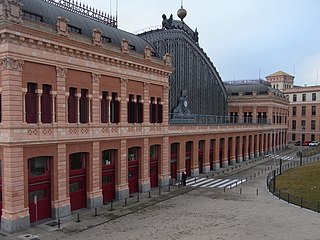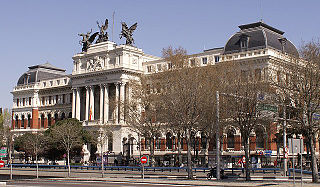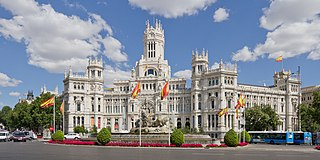
The Museo Nacional Centro de Arte Reina Sofía is Spain's national museum of 20th-century art. The museum was officially inaugurated on September 10, 1990, and is named for Queen Sofía. It is located in Madrid, near the Atocha train and metro stations, at the southern end of the so-called Golden Triangle of Art.

Madrid Atocha is the largest railway station in Madrid. It is the primary station serving commuter trains (Cercanías), regional trains from the south and southeast, intercity trains from Navarre, Cádiz and Huelva (Andalusia) and La Rioja, and the AVE high speed trains from Girona, Tarragona and Barcelona (Catalonia), Huesca and Zaragoza (Aragon), Sevilla, Córdoba, Málaga and Granada (Andalusia), Valencia, Castellón and Alicante. These train services are run by the Spanish national rail company, Renfe. As of 2019, this station has daily services to Marseille in France.

The Buen Retiro Park, Retiro Park or simply El Retiro is one of the largest parks of the city of Madrid, Spain. The park belonged to the Spanish Monarchy until the late 19th century, when it became a public park.

The Royal Palace of Madrid is the official residence of the Spanish royal family at the city of Madrid, although now used only for state ceremonies. The palace has 135,000 m2 (1,450,000 sq ft) of floor space and contains 3,418 rooms. It is the largest functioning royal palace and the largest by floor area in Europe.

The Paseo del Prado is one of the main boulevards in Madrid, Spain. It runs north–south between the Plaza de Cibeles and the Plaza del Emperador Carlos V, with the Plaza de Cánovas del Castillo lying approximately in the middle. The Paseo del Prado forms the southern end of the city's central axis. It enjoys the status of Bien de Interés Cultural (BIC), and as part of a combined UNESCO World Heritage Site with Buen Retiro Park.

The Vizcaya Bridge is a transporter bridge that links the towns of Portugalete and Las Arenas in the Biscay province of Spain, crossing the mouth of the Nervion River.

Buen Retiro Palace in Madrid was a large palace complex designed by the architect Alonso Carbonell and built on the orders of Philip IV of Spain as a secondary residence and place of recreation. It was built in what was then the eastern limits of the city of Madrid. Today, what little remains of its buildings and gardens forms the Retiro Park.

Pedro de Ribera was a Spanish architect of the Baroque period.

The Palacio de Cristal is a conservatory located in Madrid's Buen Retiro Park.

José Grases Riera was a Spanish architect from Barcelona.

The Palace of Fomento, also known as the Ministry of Agriculture Building, is a nineteenth-century office building in Madrid, Spain. Designed by Ricardo Velázquez Bosco, and built between 1893 and 1897, it is on a prominent site opposite Atocha railway station.

The School of Mining Engineering of Madrid is located in calle Ríos Rosas, Madrid, Spain. It is one of the engineering schools of the Technical University of Madrid which was founded in 1971 through the integration of the Higher Technical Schools.

Cibeles Palace, formally known as Palacio de Comunicaciones and Palacio de Telecomunicaciones until 2011, is a complex composed of two buildings with white facades and is located in one of the historical centres of Madrid, Spain. Formerly the city's main post office and telegraph and telephone headquarters, it is now occupied by Madrid City Council, serving as the city hall, and the public cultural centre CentroCentro.

Palacio de Velázquez, or Velázquez Palace is an exhibition hall located in Buen Retiro Park, Madrid, Spain.

The Exposición Nacional de Minería, Artes Metalúrgicas, Cerámica, Cristalería y Aguas Minerales was an exhibition held in Madrid, Spain in 1883. Situated in the Parque del Buen Retiro between May and November, it was presided over by King Alfonso XII of Spain and his wife Queen Maria Christina of Austria. Several countries participated.

Ricardo Velázquez Bosco (1843–1923) was a Spanish architect, archaeologist and scholar.

Daniel Zuloaga y Boneta was a Spanish ceramist and painter. He is considered to be one of the innovators of art pottery in Spain. He worked primarily from his workshops in Madrid and Segovia, but his work extended throughout Spain. He participated in various international exhibitions, and his pieces can be found in other European countries. His work was characterized by using ancient techniques. Through the influence of his father, Zuloaga worked in his youth at the Royal Palace of Madrid. After training in France, Zuloaga and his brothers opened their first shop in the Real Fábrica de La Moncloa, its most representative work being the facades of the Palacio de Velázquez. His other works appear at the Palacio de Cristal and the Hospital of Maudes, among many others.

The architecture of Madrid has preserved the look and feel of many of its historic neighbourhoods and streets, even though Madrid possesses a modern infrastructure. Its landmarks include the Royal Palace of Madrid, the Royal Theatre with its restored 1850 Opera House, the Buen Retiro Park, the 19th-century National Library building containing some of Spain's historical archives, a large number of national museums, and the Golden Triangle of Art located along the Paseo del Prado and comprising three art museums: Prado Museum, the Reina Sofía Museum, and the Thyssen-Bornemisza Museum, which completes the shortcomings of the other two museums. Cibeles Palace and Fountain have become the monument symbol of the city.

The Palacio del Marqués de Alcañices, also known as Palacio de Alcañices was a building, now disappeared, which was located in the Calle de Alcalá of Madrid on the land that was other building that occupied Luis Méndez de Haro 6th Marquis del Carpio, a favorite of Philip IV. It belonged to the parish of San Sebastián, and occupied the number 74 of the modern numbering of the street; its other façade bordering the Paseo del Prado. Was named after its owners, the last one José Osorio y Silva, mentor of Alfonso XIII, known as Pepe Osorio and the Grand Duke of Sesto, who also held the title of Marquess of Alcañices, among others.

The Jester Calabacillas is a 1626-1632 oil on canvas painting by Diego Velázquez, now in the Cleveland Museum of Art. Its attribution is based on stylistic similarities to other works by the artist - for example, José López-Rey sees similarities in the treatment of the face in this work and that of Bacchus in The Triumph of Bacchus. Its subject is thought to be the jester Juan Calebasse, also painted by the artist in a work now in Madrid and a now-lost work entitled "calebasses in a turban", the latter recorded in 1642 and 1655 inventories of Diego Felipez de Guzmán's collection.

























